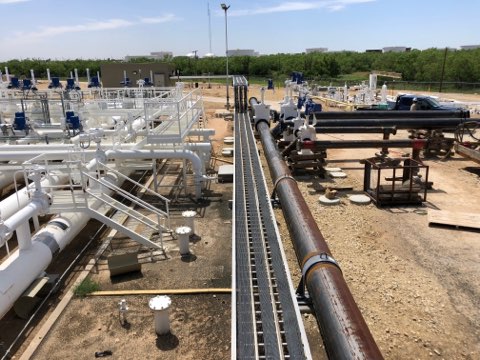The benefits of working with Superior Oilfield Rentals in large-scale drilling
All Regarding Oil Field Equipment and Pipeline Equipment: Secret Insights and Crucial Information
Oil field equipment and pipeline systems play a crucial duty in the oil and gas market. They are vital for the effective removal and transportation of hydrocarbons. Key parts, such as piercing rigs and tank, straight impact functional success. On the other hand, improvements in technology pledge to boost safety and security and effectiveness. Understanding these aspects is crucial for any person associated with or interested in this complicated sector, as it establishes the phase for deeper expedition of sector techniques.

Introduction of Oil Field Equipment
As the need for oil remains to expand, comprehending the devices used in oil areas comes to be significantly essential. Oil field equipment includes a variety of machinery and tools vital for exploration, extraction, and processing. Key elements consist of piercing rigs, which are vital for reaching oil tanks, and manufacturing devices, such as separators and pumps, that facilitate the extraction procedure. Superior Rentals reviews. Additionally, tank play a considerable duty in holding petroleum prior to transportation. Safety equipment, including blowout preventers and pressure evaluates, guarantees operational safety and performance. Each piece of equipment functions cohesively to maximize manufacturing and preserve reliable workflow. Knowledge with this equipment is necessary for professionals in the industry to assure successful procedures and adherence to safety criteria
Sorts Of Drilling Rigs and Their Applications
Drilling rigs work as the backbone of oil removal operations, with various kinds made for certain geological problems and functional requirements. One of the most usual types consist of rotating boring rigs, which utilize a turning drill little bit to penetrate the planet, and cable television tool rigs, understood for their percussion drilling approach. For offshore operations, jack-up rigs and semi-submersible rigs provide security and support in marine environments. In addition, directional exploration rigs allow drivers to drill at angles, reaching down payments that are not vertically easily accessible. Each gear type has distinct benefits, maximizing performance and security based upon the exploration atmosphere. Picking the suitable gear is crucial for taking full advantage of resource removal while reducing ecological effect and operational prices.

Crucial Pipeline Equipment and Their Functions
Pipeline infrastructure is essential for the transport of oil and gas from extraction sites to refining facilities and end-users. Various important devices elements promote this process. Pipes themselves act as the main conduits, made to stand up to high stress and corrosive materials. Pump terminals are essential for maintaining flow by enhancing pressure along the pipeline. Valves play an important duty in regulating flow and separating areas for upkeep. Furthermore, fittings and ports guarantee safe and secure joints between pipe sections. Monitoring systems, including circulation meters and pressure sensors, are important for finding leakages and maximizing circulation prices. Pigging equipment is utilized for upkeep and cleaning, guarding pipeline honesty and effectiveness. Together, these parts form the backbone of a trusted pipeline system.
Innovations and Technologies in Oil and Gas Equipment

Safety And Security and Maintenance Practices in the Oil Market
While the oil industry has made significant strides in innovation and performance, the significance of robust security and upkeep practices can not be overstated. Efficient security protocols are important to secure workers and the setting, lessening the threat of mishaps and spills. Normal inspections and maintenance of devices help identify prospective problems before they intensify, making certain operational stability. Training programs for employees are essential, emphasizing the importance of security awareness and emergency situation action procedures. Furthermore, adherence to industry policies and standards fosters a society of safety and security. Applying advanced monitoring innovations can additionally enhance upkeep techniques, permitting real-time analyses of tools conditions. Ultimately, prioritizing security and upkeep is important to the sustainability and success of the oil market.
Regularly Asked Questions
What Are the Environmental Impacts of Oil Field Equipment?
The environmental effects of oil field equipment include environment devastation, water contamination, and air contamination (Superior Rentals fusion machines). In addition, devices malfunction can result in spills, adversely affecting wildlife and ecosystems, highlighting the requirement for stringent policies and tracking
Just How Is Oil Field Equipment Transferred to Remote Locations?
Delivering oil field equipment to remote places usually involves specific lorries, helicopters, or barges. Logistics companies coordinate paths, making sure tools shows up safely and efficiently, thinking about terrain and accessibility to reduce delays and make the most of performance.
What Regulatory Requirements Govern Oil Field Equipment?
Regulative standards governing oil field equipment primarily include security, environmental management, and operational efficiency guidelines. Agencies such as OSHA and EPA implement these guidelines to ensure secure techniques and reduce ecological effect in oil removal procedures.
What Skills Are Needed to Operate Oil Field Machinery?

How Do Oil Costs Affect Equipment Demand and Use?
Oil costs substantially affect tools need and usage. Greater prices typically result in increased expedition and production tasks, driving need for equipment. Conversely, lower prices may cause minimized procedures and decreased requirement for devices.